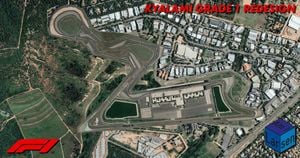Military preparations and acquisitions within the Middle East have recently intensified, showcasing how imperative it is for nations to bolster their defense capabilities amid regional tensions. Israel, for example, made headlines with its $5.2 billion deal to acquire 25 new F-15 fighter jets. The Israeli Ministry of Defense heralded this agreement as "a landmark transaction," affirming the aircraft's delivery is slated to begin by 2031. Importantly, these plans come during a period of heightened confrontations involving Israel and Iranian-backed groups across Gaza, Lebanon, and Yemen. Notably, the dynamics have seen U.S. F-15s deployed to the region, emphasizing the still-relevant performance of these aircraft which first took flight back in the 1970s.
Maj. Gen. (Res.) Eyal Zamir, director of the Israeli Ministry of Defense, emphasized the significance of this transaction, especially after the recent conflicts prompted discussions around strengthening Israel's military capabilities. The announcement came following extensive negotiations between the Israeli Ministry of Defense and Boeing, reflecting the deep-rooted military partnerships forged over decades. The urgency surrounding such military deals is invariably linked to the increase in cross-border tensions, particularly following the October 7 attack by Hamas.
Meanwhile, at Fort Leavenworth, Kansas, approximately 150 National Guard soldiers gathered to prepare for their impending deployment to the Middle East under the auspices of Task Force Spartan. The training, spanning from October 28-31, was part of their Warfighter training rotation, integral for readying the 42nd Infantry Division's headquarters to lead the 10,000-soldier force set to deploy next summer. Key leadership and noncommissioned officers participated, focusing on developing command and operational skills necessary for high-stake military engagements.
Col. Andrew Couchman, the division's operations officer, highlighted the necessity of aligning with the Army's latest warfighting doctrine as they gear up for the mission. It points to the Army's shift back toward preparing for large-scale combat scenarios, moving away from years of engagements against insurgencies. Col. Couchman detailed how this training week at Fort Leavenworth was pivotal for fostering expeditionary mission command skills among senior commanders, particularly as they gear up for future conflicts.
This military readiness is accentuated by historical deployments, which include significant operations like Task Force Liberty during the Iraq War and support roles during Operation Spartan Shield. Given this backdrop, there's clearly been considerable focus on ensuring the division's units are fully manned, equipped, and well-versed with protocols prior to their operational engagement.
On the technological front, the modernization of military capabilities is becoming increasingly intertwined with international defense strategies. For example, recent discussions have also centered on Israel’s contemplation of additional arms, particularly as tensions loom with adversarial states. The Israeli Air Force’s recent operations have showcased how the newly acquired F-15s will bolster capabilities to neutralize threats from Iranian proxies.
The need for advanced military hardware isn’t exclusive to Israel; several nations within the region are reevaluatings their military assets and aligning them with contemporary warfare norms. The U.S. has recognized this shift and, following the F-15 deal, approved significant military sales to other allied nations, such as South Korea’s potential acquisition of the E-7 Wedgetail for approximately $4.9 billion. This system will support airborne early warning and control capabilities, mirroring the broader trend of advanced military integration.
Shifting gears to the Arab world's defense infrastructure, Saudi Arabia and the UAE are also actively seeking to modernize their arms. For Saudi Arabia, the impact of U.S. electoral politics may introduce variables impacting its effort to normalize relations with Israel and accelerate arms sales to Gulf states. The complex interplay of diplomatic relations and military preparedness demonstrates how politics are inexorably linked to regional security strategies.
France, too, has been proactive by supplying Ukraine with loitering munitions, indicating the European nations' hands on approach to military procurements and support for allied nations embroiled in conflict. Defense analysts find this movement speaks volumes about how military investments influence geopolitical climates and alliances.
The crafting of collective security arrangements and military partnerships continues to evolve through procurement initiatives across the Middle East. Countries are increasingly recognizing the value of integrating new technologies and weapon systems to maintain readiness and efficacy against potential threats. The U.S. military’s engagement, especially with the discussions surrounding the training of National Guard soldiers heading to the Middle East, signals the strategic maneuvers being employed as nations brace themselves for heightened responsibilities.
All these developments reflect not just the acquisition and dynamics within the battlefield but highlight the broader strategic transformations taking place. The preparations and military deals, such as the significant new F-15 purchase, offer insights not just for Israel's future operations, but illuminate how countries are adjusting their military postures and collaborative strategies to address cyclical regional tensions. With countries reassessing their defense postures, investors and policymakers alike will undoubtedly be paying close attention to the outcomes of these military exercises and acquisitions as the geopolitical climate continues to shift.



